2. 核工业270研究所, 南昌 330200
2. Research Institute No. 270, CNNC, Nanchang 330200, China
在矿床学研究中,热液矿床的直接定年一直是研究的难点,但却是探讨成矿物质来源、认识成矿时代和地质事件之间关系以及建立矿床成因模式的关键。目前常用的定年方法包括硫化物Rb-Sr法(Nakai et al., 1990; Christensen et al., 1995)、辉钼矿Re-Os方法(Stein et al., 1998; Mao et al., 1999; Peng et al., 2006; Hu et al., 2012)、脉石矿物Sm-Nd法(Bell et al., 1989; Jiang et al., 2000; Peng et al., 2003; Henjes-Kunst et al., 2014)、黄铁矿40Ar-39Ar法(York et al., 1982; Smith et al., 2001)等。其中闪锌矿的Rb-Sr等时线测年被公认为是铅锌矿床较理想的定年方法(Nakai et al., 1993)。闪锌矿是铅锌矿床的主要矿石矿物之一,在许多铅锌矿床中闪锌矿常具多个世代、多种结构、多种颜色产出,表明其形成贯穿整个成矿过程,且闪锌矿中Rb、Sr主要赋存在包裹体或者矿物晶格中,其Rb、Sr含量和Rb/Sr比值会有变化,从而满足定年的条件,具有直接定年的潜力(Nakai et al., 1990; 赵葵东和蒋少涌, 2004)。该方法首次成功应用于美国田纳西密西西比河谷型(MVT)铅锌矿床,获得矿床形成的精确年龄为377±29Ma (Nakai et al., 1990)。此后,闪锌矿的Rb-Sr同位素定年方法被学者广泛采用(Brannon et al., 1992; Schneider et al., 2003; 徐贻赣等, 2013; Hu et al., 2015),近几年来,该方法进一步发展应用于其他金属硫化物,如黄铁矿(Yang and Zhou, 2001; 韩以贵等, 2007; Li et al., 2008)、黄铜矿(张瑞斌等, 2008; Wan et al., 2009)以及硫砷铊汞矿(Tretbar et al., 2000)等,取得了良好的定年效果。
Rb-Sr同位素体系除用于直接测定成矿时间外,Sr同位素还能够提供成矿流体来源和演化方面信息(Kesler et al., 1983; Castorina and Masi, 2000)。Sr和Ca离子半径相近,因此Sr常以分散状态出现在含Ca的矿物中,如方解石、斜长石、磷灰石等(Chapman and Spooner, 1977)。而Rb和K离子半径也很接近,因此在云母、长石等含K矿物中Rb的衰变会使得矿物中87Sr逐渐增多(Bell et al., 1989)。但是,由于Rb和Sr不能进入硫化物晶格,仅能赋存于硫化物的包体矿物(通常为云母、长石等热液矿物)或流体包裹体中(Nakai et al., 1990; 李华芹, 1993),因此,硫化物的Sr同位素组成可反映硫化物沉淀时的流体特征(Barton and Hallbauer, 1996; Lüders and Ziemann, 1999; Voicu et al., 2000),此外,Sr同位素属于重同位素,同位素分馏作用不明显,因此Sr同位素是示踪成矿流体来源的重要指示剂(Pettke and Diamond, 1997; 祁进平等, 2009; Moussa et al., 2017)。
赣杭构造带是我国最主要的火山岩型铀成矿带,发育有相山、大洲、新路、盛源等多个含铀火山盆地,同时也发育有冷水坑铅锌银矿、德兴铜矿、银山铅锌银矿、金山金矿等多个铜铅锌银金矿床,构成了一条罕见的板内U、Cu、Pb、Zn、Ag、Au、W、Sn、Nb、Ta、REE等铀多金属成矿带(Zaw et al., 2007; 毛景文等, 2008, 2011; Hu and Zhou, 2012)。该带上的相山矿田是我国最富、最大的火山岩型铀矿田,几十年来,大量学者对该矿田内的铀矿床开展了详细的矿床特征(Lin et al., 2006; 邵飞等, 2008)、成矿流体特征(Hu et al., 2009; 张树明等, 2012)、成矿年代学及成矿物质来源(范洪海等, 2001; Jiang et al., 2006; 邵飞等, 2008)、成矿机理(范洪海等, 2003; 张万良和余西垂, 2011; 李子颖等, 2014)等方面的研究工作,认为相山地区火山岩型铀矿主成矿时代晚于围岩火山岩约40Ma,且成矿过程中有幔源组分的参与(赵军红等, 2002; Hu et al., 2008, 2009; 李子颖等, 2014)。近年来,随着勘探深度不断增加,在相山深部相继发现了大量热液脉状多金属矿化,且矿化出现铜-铅锌-银的分带现象(刘军港等,2019b)。前人对相山深部的多金属开展了矿化地质特征(杨庆坤等, 2014; 张万良和邹茂卿, 2014; 王健等, 2016)、矿石组构学和矿物学(刘军港等, 2019b)、石英和方解石流体包裹体(聂江涛等, 2015; 王健等, 2015)、矿石S-Pb-He-Ar同位素和微量元素(杨庆坤等, 2015, 2017; 刘军港等, 2017, 2019a)等成矿流体特征、成矿物质来源方面研究,取得了一系列的成果。但相对于相山地区研究程度较高的热液型铀矿成矿作用,深部热液脉型多金属矿化成矿时代和成矿流体演化特征方面缺乏系统的研究,很大程度上制约了对深部多金属矿化成矿作用以及相山铀-多金属成矿系统的认识。为此本文选取相山深部多金属矿化阶段的闪锌矿和不同阶段毒砂、黄铁矿、方铅矿等及含矿围岩火山岩开展了Rb-Sr同位素研究,以期对深部多金属成矿时代和成矿流体来源及演化进行约束。
1 研究区地质概况相山铀矿田位于江西省抚州市境内,大地构造上处于扬子板块与华夏板块缝合带南缘(张国伟等, 2013),遂川-德兴深断裂南东侧,赣杭构造带西南端(Gilder et al., 1996; 余心起等, 2006),是重要中生代铀-多金属矿田(图 1)。赣杭构造带东至浙江绍兴,西至江西乐安,长约600km,宽约50km (Gilder et al., 1995),大地构造上同时受控于江山-绍兴(扬子克拉通和华夏地块界线)和五洲-永丰(华夏地块内)深断裂(杨明桂和梅勇文, 1997)。赣杭构造带由一系列以早白垩统长英质火山岩为主的火山盆地组成,该火山岩被认为与中生代太平洋板块的俯冲到欧亚板块之下有关(Li and Li, 2007; Yang et al., 2011, 2012)。
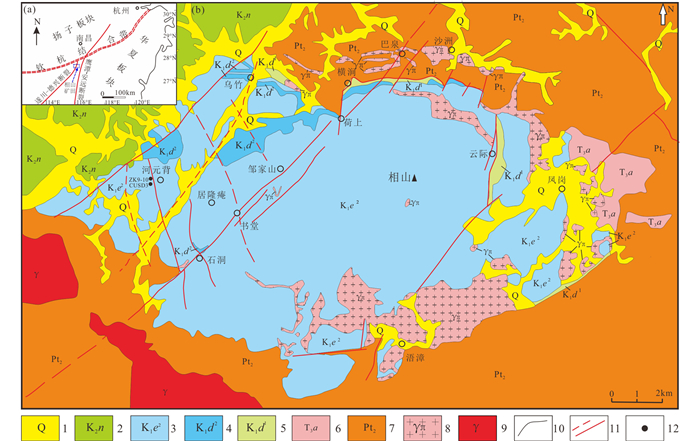
|
图 1 相山铀矿田大地构造位置图(a)和地质简图(b)(据余心起等,2006;张万良和邹茂卿,2014) 1-第四系粘土、砾石;2-上白垩统南雄组红色砂岩、砂砾岩;3-下白垩统鹅湖岭组碎斑流纹岩;4-下白垩统打鼓顶组流纹英安岩;5-下白垩统打鼓顶组砂岩、熔结凝灰岩;6-上三叠统安源组石英砂岩、页岩;7-中元古界片岩、千枚岩;8-流纹英安(斑)岩;9-花岗斑岩;10-地质界线;11-断裂;12-采样钻孔 Fig. 1 The tectonic location sketch map (a) and geological sketch map of Xiangshan uranium ore field (b) (after Yu et al., 2006; Zhang and Zou, 2014) 1-Quaternary clay and gravel; 2-sandstone and glutenite of Nanxiong Fm., Upper Cretaceous; 3-crystal tuffs and porphyroclastic rhyolite of Ehuling Fm., Lower Cretaceous; 4-pyroclastic rock and rhyodacite of Daguding Fm., Lower Cretaceous; 5-sandstone and welded tuff of Daguding Fm., Lower Cretaceous; 6-sandstone of Anyuan Fm., Upper Triassic; 7-Mesoproterozoic metamorphic rocks; 8-pyroclastic porphyric rock; 9-granite porphyry; 10-geological boundary; 11-fault; 12-location of sampling drill |
相山火山盆地的具有明显3层结构(图 1):由碎斑流纹岩、流纹英安岩和次火山岩(花岗斑岩)组成的火山-侵入杂岩体,厚度超过2000m,相山火山岩的形成时代集屮在135Ma左右(137~134Ma)(杨水源等, 2013),深部次火山岩形成时代为129.9±0.9Ma(彭中用等, 2018),是一次集屮且短暂的火山-侵入活动,它们可能为地壳深处已经脱水和麻粒岩化的屮元古界变质岩部分熔融形成的富碱的高温A型岩浆(Yang et al., 2011, 2012)。盆地基底主要为早-中元古界和震旦系的低绿片岩相和低角闪岩相的变质岩系(胡恭任等, 1997)。盆地火山岩被晚白垩纪红层覆盖。
研究区内目前发现的铅锌(银、铜)矿化主要发育于矿田西部,均在钻孔较深的位置发现,根据ZK9-10、ZK24-9、ZK26-9、ZK26-11、ZK26-13、ZK26-101、ZK28-9和CUSD3钻孔资料显示,铅锌多金属矿化位于铀矿化下部,主要分布于NNW向的河元背-小陂断裂及旁侧的次级构造中(图 2),总体产状大致与河元背-小陂断裂平行,倾向250°~260°,倾角60°~65°。多金属矿化对围岩无选择性,矿脉主要赋存于鹅湖岭组上段碎斑流纹岩和打鼓顶组上段流纹英安岩中(图 3a, b),少量赋存于鹅湖岭组下段晶屑凝灰岩、打鼓顶组下段泥质粉砂岩(图 3c)以及中元古界变质岩中(图 3d),呈脉状、浸染状,矿脉厚几毫米至几厘米(图 3a-d),局部形成0.5~2m富矿脉。根据矿物组合,矿床发育四种矿化类型:石英-毒砂-黄铜矿脉、黄铁矿脉、方铅矿-闪锌矿脉和银-碳酸盐脉,四种矿化类型在垂向呈明显分带性(刘军港等, 2019b)。围岩蚀变种类主要有碳酸盐化(图 3i)、绿泥石化(图 3j)、绢云母化(图 3k)、硅化(图 3k)和黄铁矿化(图 3g,k),局部发育少量的泥化、褐铁矿化。矿化与黄铁绢英岩化和绿泥石化最为密切,其次为碳酸盐化;从蚀变强度来看绢云母化最为发育,其次为绿泥石化,碳酸盐化多伴随硅化出现,主要以菱铁矿、方解石的形式存在(图 3h)。根据矿脉穿插关系、矿物形成顺序和围岩蚀变特征,多金属矿化可划分为矿前碱性流体作用期、多金属矿化期和矿后碳酸盐-硅化期,其中矿前期以形成绿泥石、锡石和金红石为特征,多金属矿化期又可进一步分为石英-毒砂阶段(S1,图 3e)、无矿黄铁矿阶段(S2)、铅锌多金属阶段(S3)、铅锌银碳酸盐阶段(S4) (刘军港等, 2019b),具体见图 4,其中S3阶段为主成矿阶段,矿物自形程度较高(图 3f)。
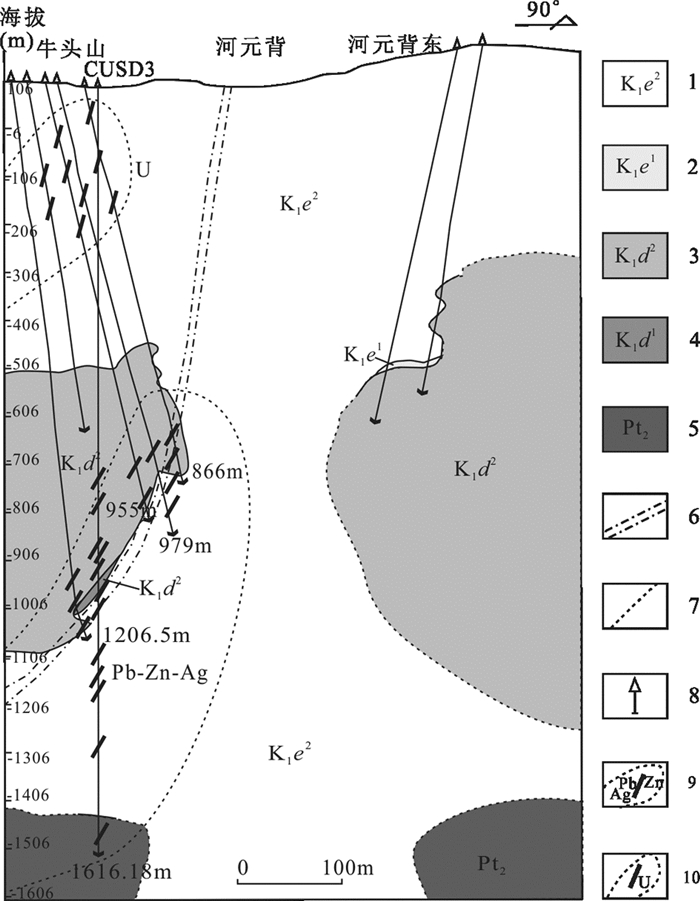
|
图 2 相山铀矿田西部26号线剖面图(据吴志坚和胡志华, 2014修改) 1-下白垩统鹅湖岭组上段碎斑流纹岩; 2-下白垩统鹅湖岭组下段晶屑凝灰岩; 3-下白垩统打鼓顶组上段流纹英安岩;4-下白垩统打鼓顶组下段火山碎屑岩; 5-中元古界变质岩; 6-河元背-小陂断裂; 7-推测地质界线; 8-钻孔; 9-铅锌银矿化; 10-铀矿化 Fig. 2 No. 26 stratigraphic section of western Xiangshan uranium ore field (modified after Wu and Hu, 2014) 1-porphyroclastic rhyolite of Upper Ehuling Fm., Lower Cretaceous; 2-crystal tuff of Lower Ehuling Fm., Lower Cretaceous; 3-rhyodacite of Upper Daguding Fm., Lower Cretaceous; 4-volcanoclastic rock of Lower Daguding Fm., Lower Cretaceous; 5-Mesoproterozoic metamorphic rocks; 6-Heyuanbei-Xiaopi fault; 7-inferred geological boundary; 8-drill hole; 9-polymetalic mineralization; 10-uranium mineralization |
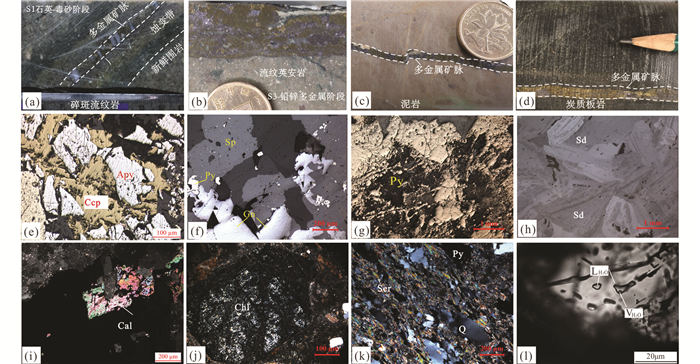
|
图 3 相山铀矿田西部地区深部多金属矿化地质特征照片 (a)早阶段(S1)石英毒砂脉及旁侧蚀变带,围岩为碎斑流纹岩;(b)主成矿阶段(S3)铅锌多金属脉及围岩流纹英安岩;(c)泥岩中多金属矿化;(d)变质岩中多金属脉;(e) S1阶段石英毒砂脉中黄铜矿沿碎裂毒砂间隙充填;(f) S3阶段自形、半自形的方铅矿、闪锌矿;(g)碎裂不规则他形黄铁矿;(h)晚阶段菱铁矿;(i)碳酸盐化蚀变; (j)长石发生绿泥石化; (k)黄铁绢英岩化蚀变围岩; (l)闪锌矿中他形孤立分布的流体包裹体. Apy-毒砂; Sp-闪锌矿;Gn-方铅矿;Ccp-黄铜矿;Py-黄铁矿;Q-石英;Ser-绢云母;Chl-绿泥石;Sd-菱铁矿;Cal-方解石 Fig. 3 Photos of geological characteristics of deep Pb-Zn polymetallic mineralization in western Xiangshan ore feild (a) in early stage (S1), quartz arsenopyrite vein and lateral alteration zone, the surrounding rock is rhyolite; (b) main metallogenic stage (S3) Pb-Zn polymetallic veins and surrounding rock rhyolite quartzite; (c) polymetallic mineralization in mudstone; (d) polymetallic mineralization in metamorphic rocks; (e) the chalcopyrite in quartz arsenopyrite vein (S1) is filled along the gap of cataclastic arsenopyrite; (f) idiomorphic, semiidiomorphic galena and sphalerite; (g) cataclastic irregular allochthonous pyrite; (h) late stage siderite; (i) carbonate alteration; (j) beresitization alterated wall rock; (k) chloritization of feldsphar; (l) fluid inclusion in sphalerite. Apy-arsenopyrite; Sp-sphalerite; Gn-gelenite; Ccp-chalcopyrite; Py-pyrite; Q-quartz; Ser-sericite; Chl-chlorite; Sd-siderite; Cal-calcite |
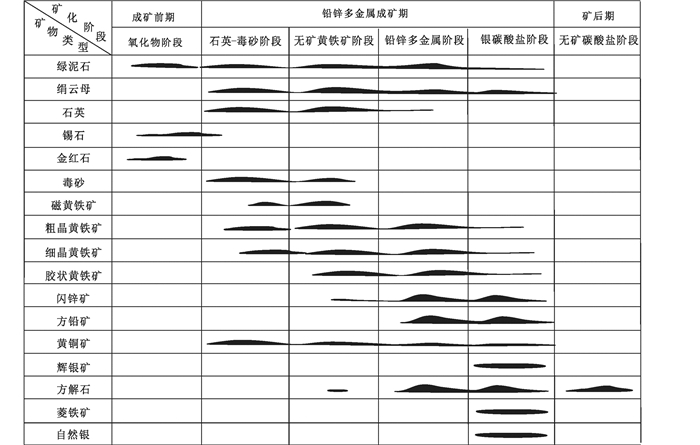
|
图 4 相山铀矿田西部地区铅锌多金属矿化阶段和矿物生成顺序简图(据刘军港等, 2019b) Fig. 4 Pb-Zn polymtallic mineralization stages from deep Pb-Zn polymetallic mineralization in western Xiangshan ore field (after Liu et al., 2019b) |
本次研究共采集的样品26件取自CUSD3、1件取自ZK9-10,然后从中挑选新鲜表面无氧化膜的毒砂、黄铁矿、闪锌矿、方铅矿、菱铁矿等单矿物样品16件(其中包括用于测年的主成矿阶段(S3)自形闪锌矿单矿物6件),以及新鲜的围岩样品17件,进行Rb、Sr同位素组成测定。首先将富含金属硫化物的矿石新鲜样品破碎至40~60目,清洗、干燥后在双目显微镜下对金属硫化物进行挑纯,使每一单矿物的纯度大于99%,再次将挑纯样品在玛瑙研钵中进行研磨,使其达到200目,全岩样品为手工破碎、研磨至200目,最后将挑纯处理的样品送实验室分析。
分析测试由核工业北京地质研究院分析测试中心完成,依据EJ/T 6921992《岩石矿物Rb-Sr等时年龄测定》方法。测试流程为:准确称取200mg单矿物或岩石粉末样品,同时加入85Rb-84Sr稀释剂,用混合酸(HNO3+HF)溶解24h,待样品完全溶解,蒸干。加入1mL浓硝酸蒸干,再加入1mL混合酸(HNO3+HF)蒸干,最后加入6mol/L的盐酸转为氯化物蒸干。用0.5mol/L的盐酸溶液溶解,离心分离,清液加入阳离子交换柱(φ0.5cm×15cm,AG50W×8(H+)100~200目),用2mol/L的盐酸溶液淋洗铷,用3mol/L的盐酸溶液淋洗锶。蒸干上质谱分析。质谱测试在IOPROBE-T热电离质谱仪上完成,对Sr的长期测试结果表明,分析精度要好于×10-5。本实验长期测试的Sr标样NBS987测试结果为87Sr/86Sr=0.71025±0.00007,Sr同位素测定过程中的分馏效应采用86Sr/88Sr=0.1194进行校正。全部操作均在净化实验室内进行,与样品同时测定的全流程空白分别为Rb=2×10-10g,Sr=2×10-10g。
3 结果与讨论 3.1 分析结果因为闪锌矿等金属矿物的Rb、Sr含量较低,甚至低于0.01×10-6,为了确定进行Rb-Sr同位素定年的可行性,首先对样品进行了微量元素Rb、Sr的测试,然后根据测定结果计算了样品的Rb/Sr值(表 1),结果显示这组样品的Rb、Sr含量较高,Rb/Sr值(0.013~0.330)变化明显,说明该组样品可以进行Rb-Sr等时线定年,年龄计算的数据拟合采用(Ludwig, 2001)编写的ISOPLOT软件,等时线回归计算是87Sr/86Sr比值采用2%误差,Sr同位素比值采用0.02%误差。计算结果121.0±3.5Ma (MSWD=2.1),87Sr/86Sr的初始值为0.714988±0.000028(图 5)。
|
|
表 1 主成矿阶段闪锌矿单矿物Rb-Sr同位素组成 Table 1 Rb-Sr dating data for sphalerites from western Xiangshan ore field |

|
图 5 相山铀矿田西部地区深部铅锌多金属矿化闪锌矿Rb-Sr等时线 Fig. 5 Rb-Sr isochron for sphalerite from polymetallic mineralization in western Xiangshan ore field |
表 2列出了各阶段矿石矿物及赋矿围岩的Sr同位素组成。通过Sr同位素的组成对于成矿物质来源进行判断,为了避免放射性87Rb衰变对Sr同位素组成造成影响,将闪锌矿、黄铁矿、方铅矿、方解石和毒砂中87Sr/86Sr值按照公式(87Sr/86Sr)i=87Sr/86Sr-87Rb/86Sr×(eλt-1)对于测试样品的初始同位素进行计算,在此λ取1.42×10-11/a,矿石样品t取值121Ma。由于成矿时代与赋矿地层有矿岩时差,必须考虑87Rb的衰变和87Sr的累积效应,赋矿围岩样品中碎斑流纹岩和流纹英安岩年龄为132Ma(杨水源等, 2013)和135Ma(杨水源等, 2010),其87Sr/86Sr值校正到成矿时代(121Ma);计算结果见表 2。
|
|
表 2 相山铀矿田西部地区深部铅锌多金属矿化Rb-Sr同位素组成 Table 2 Rb-Sr isotopic composition of single grain minerals of ore |
从表 2可以看出,不同阶段矿石单矿物样品初始Sr同位素组成变化较大,(87Sr/86Sr)i变化介于0.706114~0.718814。其中代表成矿早阶段的2件毒砂(87Sr/86Sr)i分别为0.718814和0.718516,平均0.718665,代表铅锌矿化主成矿阶段的黄铁矿的(87Sr/86Sr)i变化介于0.713804~0.715151,平均0.714322 (n=3),闪锌矿的(87Sr/86Sr)i变化介于0.714961~0.715002,平均0.714978(n=6)。代表成矿晚阶段的黄铁矿(87Sr/86Sr)i分别为0.706712和0.709832,平均0.708272 (n=2);方解石的(87Sr/86Sr)i为0.706114 (n=1);方铅矿的(87Sr/86Sr)i分别为0.711888和0.712558,平均0.712223 (n=2)。
3.2 讨论 3.2.1 成矿时代及其意义热液矿物Rb-Sr等时线年龄测年的基本前提是同源、同时、封闭性、一致的(87Sr/86Sr)i以及具有不同的87Rb/86Sr(Nakai et al., 1990; Schneider et al., 2003; 李文博等, 2006)。实验过程中,将闪锌矿粉碎至200目以下,然后进行超声波清洗,基本可排除次生包裹体的干扰,本次工作选择未见或少见裂隙,且结晶较好的致密块状矿石为研究对象,这样闪锌矿单矿物纯度相对比较高,尽量满足Rb-Sr同位素测年的前提条件,另外闪锌矿中包裹体发育,呈不规则状(图 3l),本文所利用的闪锌矿Rb-Sr定年是直接将单矿物全溶,测其Rb-Sr同位素组成,来确定其形成年龄,也直接代表了成矿年龄。
由于Rb的流动性,极易形成开放系统,得到不正确的年龄。特别在样品少的情况下,表现更为明显,因此,我们也需判断本次测定年龄的真假。前人认为假等时线可以通过以下方法判别(Petke and Diamond, 1996):(1)在Rb/Sr比值变化不大的情况下,87Sr/86Sr与1/Sr呈正相关;(2)等时线截距明显小于同时期地幔Sr同位素值,或明显高于研究区同时期地壳Sr同位素值。本文等时线由6件样品的测试结果拟合,符合常规等时线测量数目要求,Rb/Sr比值变化较大,并且87Rb/86Sr与1/Rb(图 6a)、87Sr/86Sr与1/Sr无相关关系(图 6b),初始Sr同位素值合理,因此认为本年龄真实可靠,代表铅锌多金属矿化阶段的成矿年龄。

|
图 6 相山铀矿田西部地区深部铅锌多金属矿化87Rb/86Sr-1/Rb (a)和1/Sr-87Sr/86Sr (b)关系图 Fig. 6 Diagrams of 1/Rb vs. 87Rb/86Sr (a) and 1/Sr vs. 87Sr/86Sr (b) of sphalerites from polymetallic mineralization in western Xiangshan ore field |
前人研究结果显示,铅锌多金属矿化蚀变矿物绢云母的39Ar/40Ar年龄为137.5~138.3Ma之间(杨庆坤等, 2017),处于矿田中生代火山岩浆活动阶段,但是根据野外观察可以看出,多金属矿化明显晚于围岩火山岩(图 3a-d),并且相山铀矿田西部地区热液活动频繁,无论成矿前还是成矿后都有热液活动,都能使矿物发生绢云母化,以上同火山活动时代接近的年龄更可能代表火山热液活动的时代。故此该年龄应不能代表多金属矿化年龄。因此本次采用Rb-Sr同位素测年方法测定主成矿阶段的矿石矿物闪锌矿,得出精确年龄为121.0±3.5Ma,代表铅锌多金属矿化主成矿期发生的时间。
相山铀矿田的基底地层为中元古界变质岩,远远早于多金属成矿时代,本文不做讨论。研究区盖层主要为早白垩系打鼓顶组和鹅湖岭组火山岩,为铅锌矿脉的主赋矿层位。杨水源等(2010)采用SHRIMP、LA-ICP-MS测定的流纹英安岩和流纹英安斑岩的年龄分别为135.1Ma和134.8Ma。陈正乐等(2013)采用锆石SHRIMP微区U-Pb测年技术测定相山铀矿田鹅湖岭组碎斑流纹岩的年龄为134.1Ma,似斑状花岗岩的年龄为134.7Ma,石英二长花岗斑岩的年龄为136.4Ma,流纹质英安斑岩的年龄为137.4Ma。因此相山矿田的火山喷发年龄为134~137Ma,为一次短暂的火山-侵入活动。范洪海等(2005)采用单颗粒锆石U-Pb同位素法测定火山期后的潜石英二长斑岩及煌斑岩脉的形成年龄分别为129.5Ma和125.1Ma。李子颖等(2014)测定混合花岗岩、辉绿辉长岩、石英二长斑岩和微晶辉绿岩单颗粒锆石U-Pb年龄为385Ma、167Ma、127.1Ma、127.5Ma;彭中用等(2018)测定深部次火山岩形成时代为129.9±0.9Ma;王勇剑(2015)测定晚期中基性岩脉形成时代为107~90Ma。以上结果表明,相山地区是一个长期和多次的岩浆活动中心,这为相山地区形成铀-多金属矿化提供了基础,但是多金属成矿时代与围岩存在一定的矿岩时差(约15Ma),而与最晚期的次火山岩时代较为接近,而早于晚期的基性脉岩时代。因此矿床成因可能与火山活动后期次火山期后热液作用有关。
陈繁荣等(1990)分别对相山钠交代型和萤石-水云母型矿化用沥青铀矿U-Pb法进行了测定,获得了115.2Ma和97.6Ma两期成矿年龄;陈迪云等(1993)对相山钠长石化花岗斑岩Rb-Sr等时线定年,认为第一次成矿在钠长石化之后,约为120Ma,第二期成矿为100Ma左右。李子颖等(2014)采用精淘沥青铀矿U-Pb定年结果显示年龄集中于120~128Ma和90~110Ma两个时间段,其中碱交代型铀矿化年龄为128~115Ma,萤石-水云母型铀矿化年龄104~98Ma,这代表了相山成矿作用集中于两个时间段。从成矿年龄上来看,多金属的矿化可能发生在碱交代作用发生前后,而明显早于晚阶段酸性交代期铀矿化。本文对相山铀矿田西部河元背八号带的钻孔(ZK9-10)岩心样品进行详细镜下观察发现,铅锌硫化物细脉切过早期碱交代的蚀变岩石(图 7a, d),而明显被晚期含铀萤石脉交代(图 7b, c, e, f)。因此相山铀矿田西部地区多金属矿化的发生在铀矿化碱交代阶段之后,但是时代比较接近,而明显早于晚期酸性交代铀矿化阶段,这与二者的成矿年龄数据相吻合。
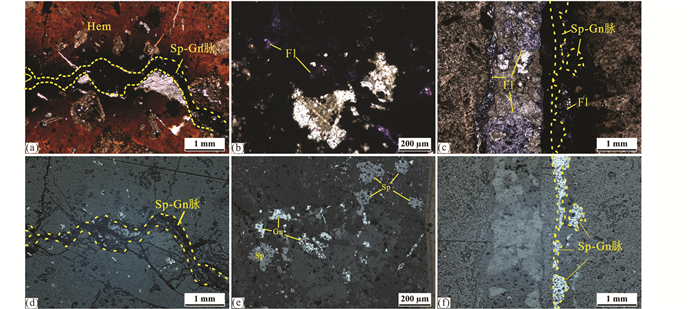
|
图 7 相山铀矿田西部地区铀矿化与多金属矿化关系照片 Hem-赤铁矿;Fl-萤石 Fig. 7 The relationship between uranium mineralization and polymetallic mineralization Hem-hematite; Fl-fluorite |
各个矿化阶段的黄铁矿颗粒不一,可见细小、呈他形、半自形细粒集合体和呈指纹状、胶状以及较为自形的粗粒黄铁矿胶结在一起(图 3g),反映黄铁矿结晶空间局限或结晶时间较短,并且形成条件复杂或者叠加后期热液作用,不利于同位素体系平衡,或者平衡遭受破坏。方铅矿中Rb含量非常低(较黄铁矿和闪锌矿多低1~2个数量级),导致其放射成因87Sr含量微乎其微,因此不是定年的理想矿物,上述表明,早、中、晚各个阶段的黄铁矿、方铅矿和方解石同位素组成变化较大,样品数据点较分散,不能给出有效的Rb-Sr等时线年龄,但其Sr同位素比值仍然显示了重要的信息,结合闪锌矿的Sr同位素比值可对矿床成因进一步约束。
由于多数硫化物87Rb/86Sr较低,介于0.0019~0.9567,平均0.2596,明显小于1,因此(87Sr/86Sr)i误差较小,且在误差范围内一致,因此可以进行用(87Sr/86Sr)i进行源区示踪(Pettke and Diamond, 1995, 1997; Han et al., 2003)。成矿早阶段围岩蚀变较弱、矿物颗粒自形程度不高,颗粒细小(图 3a, e),表明矿物沉淀速度较快或沉淀空间较为局限,流体与围岩之间相互作用较弱,加之矿石矿物均为贫Sr矿物,因此按121Ma计算的毒砂初始Sr同位素组成应能够代表流体的Sr同位素特征,并接近流体源区的Sr同位素特征。成矿主阶段和晚阶段伴随较强的碳酸盐化蚀变,表明流体富Ca、CO2等组分,因此,主成矿阶段硫化物Sr同位素组成可能受其他因素影响较大,反映的是初始成矿流体和其他流体的混合或者成矿流体进行水岩反应特征。如此以来,早阶段毒砂Sr同位素特征就成为探讨成矿系统起因和流体来源的关键,对比早阶段毒砂与相关地质体的Sr同位素地球化学特征是揭示矿床成因的关键。
Faure (1986)计算求得大陆壳平均的87Sr/86Sr比值为0.719,代表上地幔同位素组成的大洋玄武岩87Sr/86Sr初始比值在0.704±0.0002范围内。早阶段硫化物(87Sr/86Sr)i值明显高于0.7100,接近大陆地壳的比值,因此成矿流体Sr应为上地壳来源(Pettke and Diamond, 1995, 1997; Staude et al., 2011)。由表 2和图 8a, b可以看出:成矿流体与赋矿围岩具有截然不同的演化趋势,且早阶段毒砂的(87Sr/86Sr)i值(0.718665)普遍高于成矿时赋矿围岩(流纹英安岩(87Sr/86Sr)121Ma为0.712862、碎斑流纹岩(87Sr/86Sr)121Ma为0.712773),说明成矿流体更富集放射成因Sr,如果成矿流体Sr主要来源于赋矿围岩,那么很有可能为赋矿围岩与成矿热液不断反应,Rb/Sr比值比较高的火成硅酸盐矿物分解,使得87Sr在成矿流体中逐渐积累。但本文认为这种可能性均不大,因为:赋矿围岩为火成岩,岩石致密,不可能进行大范围水岩反应,即使有断裂发育,早阶段与矿化有关的围岩蚀变也仅发育与矿脉两侧(图 3a, b),蚀变强度小,反应水岩反应较弱,而且流体与赋矿围岩的不断反应,必然会导致成矿晚期热液富含87Sr/86Sr,但是中、晚阶段的87Sr/86Sr却明显降低,因此排除水岩反应导致的早期成矿流体高的Sr同位素组成。因此,成矿流体中的Sr可能并非主要来自于赋矿围岩本身,即赋矿火山岩并非成矿流体的直接提供者,结合其初始Sr同位素比值,本文认为早期成矿流体可能来自深部的壳源岩浆体系,与本矿田的铀成矿流体可能并非同一来源。

|
图 8 相山铀矿田西部地区铅锌多金属矿化Rb-Sr同位素组成 (a)矿石与围岩Rb-Sr同位素组成对比;(b) (87Sr/86Sr)i-1/Sr图解 Fig. 8 Rb-Sr isotopic composition of single grain minerals and host rocks of western Xiangshan Pb-Zn mineralization (a) the comparison diagram of Rb-Sr isotopic composition between ores and wall rocks; (b)diagram of (87Sr/86Sr)i vs. 1/Sr |
早阶段到晚阶段的87Sr/86Sr、(87Sr/86Sr)i明显呈降低的趋势(图 8b),这表明自早阶段的石英-毒砂阶段(S1阶段,早阶段)到铅锌多金属阶段(S3阶段,中阶段)再到铅锌银碳酸盐阶段(S4阶段,晚阶段)成矿流体性质发生了变化,那么导致这一变化的原因有以下可能:(1)成矿作用由同一种流体所致,随着流体与围岩相互作用的进行,流体系统的Sr同位素比值降低;(2)不同阶段为不同来源的流体混合。对于第一种可能,铅锌主成矿阶段的单矿物(87Sr/86Sr)i与围岩具有相似的组成(图 8b),低于早阶段,因此随着成矿作用的进行,不排除围岩中的Sr可逐渐影响成矿系统的可能,但是矿化特征显示不存在大规模的围岩蚀变,况且晚阶段成矿流体的(87Sr/86Sr)i明显低于围岩的(87Sr/86Sr)i值(图 8b),因此由该作用影响的(87Sr/86Sr)i的降低微乎其微。对于第二种可能,87Sr/86Sri-1/Sr图解显示了混合的Sr源(图 8b),前文提及相山深部多金属成矿流体可能与来自晚期的壳源岩浆体系,虽然有He-Ar同位素特征表明可能存在少量幔源流体加入,但是演化过程并无幔源流体增加的趋势(刘军港等, 2019a),且在矿体附近无幔源岩浆体系的存在,因此应该不存在幔源物质不断混合导致Sr同位素体系的降低可能;已有研究结果显示,不同阶段H-O同位素特征表明成矿流体演化过程伴随着大气降水的不断混合,流体包裹体研究也已证实早阶段深源含CO2的中-高盐度流体和晚阶段浅源富水低盐度流体的混合的可能为铅锌矿化的主要原因(刘军港,2017),因此早阶段至晚阶段成矿流体Sr同位素显著减低可能与大气降水的不断混合稀释有关。
3.2.3 成矿动力学背景毛景文等(2008)认为华南地区中生代主要金属矿床成矿主要集中于3个阶段,即晚三叠世(230~210Ma)的钨锡铌钽成矿系列、中晚侏罗世(170~150Ma)的斑岩-矽卡岩铜矿和花岗岩有关的钨锡多金属矿床以及早中白垩世(134~80Ma)的浅成低温热液型铜金银铀矿床,本文所测的多金属成矿时代与区域上浅成低温热液多金属矿床成矿时代一致。此外,徐贻赣等(2013)采用闪锌矿Rb-Sr同位素测年方法获得冷水坑铅锌银矿田成矿年龄为126.9±7.1Ma,张家菁等(2012)采用相同方法测得篁碧生米坑铅锌银矿床成矿年龄为135Ma,也证明了区域存在早中白垩世的一期铅锌银的成矿事件。研究表明,印支运动早期(二叠纪末或三叠纪初),扬子板块与华南陆块之间发生俯冲-陆内拼贴碰撞,华南原大地构造性质互异的各地质单元,拼合为统一的刚-塑性块体,此后,该区有了相对统一的地质历史(Gilder et al., 1995; Ling et al., 2003)。晚侏罗世(145±5Ma)以来,相山地区所处的华南陆块经历了构造格局的重大调整,地壳的受力状态由挤压转换为板内伸展,深部复杂的壳幔相互作用造成大陆岩石圈大面积伸展而形成了大量白垩纪断陷盆地和变质核杂岩,伴随大规模的火山活动和巨量花岗质岩浆侵位,并伴随大爆发成矿(Gilder et al., 1996; 毛景文和王志良, 2000; Hu et al., 2008, 2009; Hu and Zhou, 2012; 胡瑞忠等, 2015)。有部分学者认为,这可能与中生代地幔柱热点作用有关(李子颖等, 1999);而也有学者认为在早白垩世(135Ma左右),古太平洋俯冲板块改变了运动方向,由斜向俯冲调整到几乎平行大陆边缘沿NE方向走滑,导致中国东部构造体制从近东西向的特提斯构造域向北北东向的滨太平洋构造域转换从而引起了区域的伸展作用(Zhou and Li, 2000; 毛景文等, 2008; Chen et al., 2014)。也有研究认为,这个拉张环境是由于太平洋板块俯冲之后的板片后撤所引起的,持续的拉张作用导致地壳和岩石圈地幔逐渐减薄,软流圈地幔上涌并底侵引发了广泛的A型花岗质岩浆作用(Li and Li, 2007; Jiang et al., 2009, 2011; 杨水源等, 2013),并伴随形成了浅成低温热液铜金银矿化系统和热液型铀矿的形成。结合相山已有研究,本文认为相山矿田内铀矿化和深部多金属矿床均形成于早白垩世的板内伸展环境,具有一致的构造动力学背景。
4 结论(1) 江西相山铀矿田深部多金属矿化主成矿阶段的闪锌矿的Rb-Sr等时线年龄为121.0±3.5Ma,代表深部多金属矿化主成矿年龄,与围岩火山岩存在一定的矿岩时差,与晚期的次火山作用时代接近。多金属矿化的形成略晚于碱交代铀成矿期,明显早于晚期酸性交代铀成矿期。
(2) 相山深部多金属矿化初始成矿流体Sr同位素比值具有壳源特征,且明显高于围岩火山岩,成矿流体中并非主要来自于赋矿围岩本身,而来自深部的壳源岩浆体系,可能与铀成矿流体并非同一来源。多金属成矿流体演化过程中受到大气降水的不断混合稀释作用控制。
(3) 相山矿田铀矿化和多金属矿化形成于早白垩世的华南板内伸展作用背景,具有一致的成矿动力学背景。
致谢 两位匿名审稿人对论文提出了宝贵的建设性意见和建议,极大地提高了文章的质量和讨论深度;野外样品采集得到曹建辉、司志发工程师的热心帮助;微量元素和锶钕同位素测试得到核工业北京地质研究院分析测试中心刘牧高级工程师和固体同位素实验室颜妍工程师的大力支持与帮助;在此一并表示衷心感谢!
Barton ES and Hallbauer DK. 1996. Trace-element and U-Pb isotope compositions of pyrite types in the Proterozoic Black Reef, Transvaal Sequence, South Africa:Implications on genesis and age. Chemical Geology, 133(1-4): 173-199 DOI:10.1016/S0009-2541(96)00075-7 |
Bell K, Anglin CD and Franklin JM. 1989. Sm-Nd and Rb-Sr isotope systematics of scheelites:Possible implications for the age and genesis of vein-hosted gold deposits. Geology, 17(6): 500-504 DOI:10.1130/0091-7613(1989)017<0500:SNARSI>2.3.CO;2 |
Brannon JC, Podosek FA and McLimans RK. 1992. Alleghenian age of the Upper Mississippi Valley zinc-lead deposit determined by Rb-Sr dating of sphalerite. Nature, 356(6369): 509-511 DOI:10.1038/356509a0 |
Castorina F and Masi U. 2000. Sr-isotopic composition of siderite for assessing the origin of mineralizing fluids:The case study from the Jebel Awam deposit (Central Morocco). Ore Geology Reviews, 17(1-2): 83-89 DOI:10.1016/S0169-1368(00)00006-8 |
Chapman HJ and Spooner ETC. 1977. 87Sr enrichment of ophiolitic sulphide deposits in Cyprus confirms ore formation by circulating seawater. Earth and Planetary Science Letters, 35(1): 71-78 DOI:10.1016/0012-821X(77)90030-9 |
Chen DY, Zhou WB, Zhou LM, Wu BL, Tan JH and Sun ZX. 1993. Isotope geology of the Xiangshan uranium orefield. Mineral Deposits, 12(4): 370-377 (in Chinese with English abstract) |
Chen FR, Shen WZ, Wang DZ and Liu CS. 1990. Isotopic geochemistry of uranium ore-field No. 1220 and the implication to ore genesis. Geotectonica et Metallogenia, 14(1): 69-77 (in Chinese with English abstract) |
Chen W, Wan YS, Li HQ, Zhang ZQ, Dai TM, Shi ZE and Sun JB. 2011. Isotope geochronology:Technique and application. Acta Geologica Sinica, 85(11): 1917-1947 (in Chinese with English abstract) |
Chen WT, Zhou MF and Gao JF. 2014. Constraints of Sr isotopic compositions of apatite and carbonates on the origin of Fe and Cu mineralizing fluids in the Lala Fe-Cu-(Mo, LREE) deposit, SW China. Ore Geology Reviews, 61: 96-106 DOI:10.1016/j.oregeorev.2014.01.008 |
Chen ZL, Wang Y, Zhou YG, Han FB, Wang PA, Gong HL, Shao F, Tang XS and Xu JS. 2013. SHRIMP U-Pb dating of zircons from volcanic-intrusive complexes in the Xiangshan uranium orefield, Jiangxi Province, and its geological implications. Geology in China, 40(1): 217-231 (in Chinese with English abstract) |
Christensen JN, Halliday AN, Leigh KE, Randell RN and Kesler SE. 1995. Direct dating of sulfides by Rb-Sr:A critical test using the Polaris Mississippi Valley-type Zn-Pb deposit. Geochimica et Cosmochimica Acta, 59(24): 5191-5197 DOI:10.1016/0016-7037(95)00345-2 |
Fan HH, Ling HF, Wang DZ, Shen WZ, Liu CS and Jiang YH. 2001. Ore-forming material sources for Xiangshan uranium ore-field in Jiangxi Province:Evidence from Nd-Sr-Pb isotopes. Geological Journal of China Universities, 7(2): 139-145 (in Chinese with English abstract) |
Fan HH, Ling HF, Wang DZ, Liu CS, Shen WZ and Jiang YH. 2003. Study on metallogenetic mechanism of Xiangshan uranium ore-field. Uranium Geology, 19(4): 208-213 (in Chinese with English abstract) |
Fan HH, Wang DZ, Shen WZ, Liu CS, Wang X and Ling HF. 2005. Formation age of the intermediate-basic dikes and volcanic-intrusive complex in Xiangshan, Jiangxi Province. Geological Review, 51(1): 86-91 (in Chinese with English abstract) |
Faure G. 1986. Principles of Isotope Geology. 2nd. Edition. New York: John Wiley & Sons, 183-189
|
Gilder SA, Coe RS, Wu HR, Kuang GD, Zhao XX and Wu Q. 1995. Triassic paleomagnetic data from South China and their bearing on the tectonic evolution of the western circum-Pacific region. Earth and Planetary Science Letters, 131(3-4): 269-287 DOI:10.1016/0012-821X(95)00030-G |
Gilder SA, Gill J, Coe RS, Zhao XX, Liu ZW, Wang GX, Yuan KR, Liu WL, Kuang GD and Wu HR. 1996. Isotopic and paleomagnetic constraints on the Mesozoic tectonic evolution of South China. Journal of Geophysical Research:Solid Earth, 101(B7): 16137-16154 DOI:10.1029/96JB00662 |
Han RS, Liu CQ and Huang ZL. 2003. Rb-Sr isotope evidence for sources of ore-forming fluid in Huize Zn-Pb-(Ag) district, Yunnan, China. Geochimica et Cosmochimica Acta Supplement, 67(18): 132 |
Han YG, Li XH, Zhang SH, Zhang YH and Chen FK. 2007. Single grain Rb-Sr dating of euhedral and cataclastic pyrite from the Qiyugou gold deposit in western Henan, central China. Chinese Science Bulletin, 52(13): 1820-1826 DOI:10.1007/s11434-007-0248-3 |
Henjes-Kunst F, Prochaska W, Niedermayr A, Sullivan N and Baxter E. 2014. Sm-Nd dating of hydrothermal carbonate formation:An example from the Breitenau magnesite deposit (Styria, Austria). Chemical Geology, 387: 184-201 DOI:10.1016/j.chemgeo.2014.07.025 |
Hu GR, Zhang BT and Wang CH. 1997. First determination of the Neoproterozoic metamorphic rocks in Xiangshan, central Jiangxi Province. Regional Geology of China, 16(2): 222-224 (in Chinese with English abstract) |
Hu QQ, Wang YT, Mao JW, Wei R, Liu SY, Ye DJ, Yuan QH and Dou P. 2015. Timing of the formation of the Changba-Lijiagou Pb-Zn ore deposit, Gansu Province, China:Evidence from Rb-Sr isotopic dating of sulfides. Journal of Asian Earth Sciences, 103: 350-359 DOI:10.1016/j.jseaes.2014.10.021 |
Hu RZ, Bi XW, Zhou MF, Peng JT, Su WC, Liu S and Qi HW. 2008. Uranium metallogenesis in South China and its relationship to crustal extension during the Cretaceous to Tertiary. Economic Geology, 103(3): 583-598 DOI:10.2113/gsecongeo.103.3.583 |
Hu RZ, Burnard PG, Bi XW, Zhou MF, Peng JT, Su WC and Zhao JH. 2009. Mantle-derived gaseous components in ore-forming fluids of the Xiangshan uranium deposit, Jiangxi Province, China:Evidence from He, Ar and C isotopes. Chemical Geology, 266(1-2): 86-95 DOI:10.1016/j.chemgeo.2008.07.017 |
Hu RZ and Zhou MF. 2012. Multiple Mesozoic mineralization events in south China:An introduction to the thematic issue. Mineralium Deposita, 47(6): 579-588 DOI:10.1007/s00126-012-0431-6 |
Hu RZ, Wei WF, Bi XW, Peng JT, Qi YQ, Wu LY and Chen YW. 2012. Molybdenite Re-Os and muscovite 40Ar/39Ar dating of the Xihuashan tungsten deposit, central Nanling district, South China. Lithos, 150: 111-118 DOI:10.1016/j.lithos.2012.05.015 |
Hu RZ, Mao JW, Hua RM and Fan WM. 2015. Intra-continental Mineralization of South China Craton. Beijing: Science Press, 1-903 (in Chinese)
|
Jiang SY, Slack JF and Palmer MR. 2000. Sm-Nd dating of the giant Sullivan Pb-Zn-Ag deposit, British Columbia. Geology, 28(8): 751-754 DOI:10.1130/0091-7613(2000)28<751:SDOTGS>2.0.CO;2 |
Jiang YH, Ling HF, Jiang SY, Shen WZ, Fan HH and Ni P. 2006. Trace element and Sr-Nd isotope geochemistry of fluorite from the Xiangshan uranium deposit, Southeast China. Economic Geology, 101(8): 1613-1622 DOI:10.2113/gsecongeo.101.8.1613 |
Jiang YH, Jiang SY, Dai BZ, Liao SY, Zhao KD and Ling HF. 2009. Middle to Late Jurassic felsic and mafic magmatism in southern Hunan Province, Southeast China:Implications for a continental arc to rifting. Lithos, 107(3-4): 185-204 DOI:10.1016/j.lithos.2008.10.006 |
Jiang YH, Zhao P, Zhou Q, Liao SY and Jin GD. 2011. Petrogenesis and tectonic implications of Early Cretaceous S-and A-type granites in the northwest of the Gan-Hang rift, SE China. Lithos, 121(1-4): 55-73 DOI:10.1016/j.lithos.2010.10.001 |
Kesler SE, Ruiz J and Jones LM. 1983. Strontium-isotopic geochemistry of fluorite mineralization (Coahuila, Mexico). Chemical Geology, 41: 65-75 DOI:10.1016/S0009-2541(83)80006-0 |
Li HQ. 1993. Study on the Chronology and Geological Application of Fluid Inclusion in Hydrothermal Deposits. Beijing: Geological Publishing House, 1-178 (in Chinese)
|
Li QL, Chen FK, Yang JH and Fan HR. 2008. Single grain pyrite Rb-Sr dating of the Linglong gold deposit, eastern China. Ore Geology Reviews, 34(3): 263-270 DOI:10.1016/j.oregeorev.2007.10.003 |
Li WB, Huang ZL, Xu DR, Chen J, Xu C and Guan T. 2006. Rb-Sr isotopic method on zinc-lead ore deposits:A review. Geotectonica et Metallogenia, 26(4): 436-441 (in Chinese with English abstract) |
Li ZX and Li XH. 2007. Formation of the 1300-km-wide intracontinental orogen and postorogenic magmatic province in Mesozoic South China:A flat-slab subduction model. Geology, 35(2): 179-182 DOI:10.1130/G23193A.1 |
Li ZY, Li XZ and Lin JR. 1999. On the Meso Cenozoic mantle plume tectonics, its relationship to uranium metallogenesis and prospecting directions in South China. Uranium Geology, 15(1): 9-17, 34 (in Chinese with English abstract) |
Li ZY, Huang ZZ, Li XZ, Zhang JD, Lin ZY and Zhang YY. 2014. Pyrogenesis and Uranium Metallogeny in Xiangshan Volcanic Basin, South China. Beijing: Geological Publishing House, 1-324 (in Chinese)
|
Lin G, Zhou Y, Wei XR and Zhao CB. 2006. Structural controls on fluid flow and related mineralization in the Xiangshan uranium deposit, southern China. Journal of Geochemical Exploration, 89(1-3): 231-234 DOI:10.1016/j.gexplo.2005.11.051 |
Ling WL, Gao S, Zhang BR, Li HM, Liu Y and Cheng JP. 2003. Neoproterozoic tectonic evolution of the northwestern Yangtze craton, South China:Implications for amalgamation and break-up of the Rodinia supercontinent. Precambrian Research, 122(1-4): 111-140 DOI:10.1016/S0301-9268(02)00222-X |
Liu JG. 2017. Study on uranium-polymetallic mineralization in western Xiangshan ore field. Ph. D. Dissertation. Beijing: Beijing Research Institute of Uranium Geology, 1-215 (in Chinese with English summary)
|
Liu JG, Li ZY and Nie JT. 2017. The S isotope geochemical characteristics and its geological implications of lead-zinc polymetallic mineralization in Xiangshan ore field, Jiangxi Provice. Geological Review, 63(Suppl.): 237-238 (in Chinese) |
Liu JG, Li ZY, Nie JT and Wang J. 2019a. Origin of ore-forming fluids in the deep polymetallic mineralization in western Xiangshan uranium ore field, Jiangxi Province, China:Constraints from He-Ar isotopes. Geotectonica et Metallogenia, 43(2): 271-282 (in Chinese with English abstract) |
Liu JG, Li ZY, Nie JT, Wang J and Li XZ. 2019b. Ore fabric and mineralogy of polymetallic mineralization in western Xiangshan uranium orefield, Jiangxi Province. Mineral Deposits, 38(2): 367-381 (in Chinese with English abstract) |
Lüders V and Ziemann M. 1999. Possibilities and limits of infrared light microthermometry applied to studies of pyrite-hosted fluid inclusions. Chemical Geology, 154(1-4): 169-178 DOI:10.1016/S0009-2541(98)00130-2 |
Ludwig K R. 2001. Users Manual for Isoplot/Ex Rev. 2.49. Berkeley: Berkeley Geochronology Center
|
Mao JW, Zhang ZC, Zhang ZH and Du AD. 1999. Re-Os isotopic dating of molybdenites in the Xiaoliugou W(Mo) deposit in the northern Qilian mountains and its geological significance. Geochimica et Cosmochimica Acta, 63(11-12): 1815-1818 DOI:10.1016/S0016-7037(99)00165-9 |
Mao JW and Wang ZL. 2000. A preliminary study on time limits and geodynamic setting of large-scale metallogeny in East China. Mineral Deposits, 19(4): 289-296 (in Chinese with English abstract) |
Mao JW, Xie GQ, Guo CL, Yuan SD and Chen YB and Chen YC. 2008. Spatial-temporal distribution of Mesozoic ore deposits in South China and their metallogenic settings. Geological Journal of China Universities, 14(4): 510-526 (in Chinese with English abstract) |
Mao JW, Chen MH, Yuan SD and Guo CL. 2011. Geological characteristics of the Qinhang (or Shihang) metallogenic belt in South China and spatial-temporal distribution regularity of mineral deposits. Acta Geologica Sinica, 85(5): 636-658 (in Chinese with English abstract) |
Moussa N, Rouxel O, Grassineau NV, Ponzevera E, Nonnotte P, Fouquet Y and Le Gall B. 2017. Sulfur and srontium isotopic study of epithermal mineralization:A case study from the SE Afar Rift, Djibouti. Ore Geology Reviews, 81: 358-368 DOI:10.1016/j.oregeorev.2016.10.028 |
Nakai S, Halliday AN, Kesler SE and Jones HD. 1990. Rb-Sr dating of sphalerites from Tennessee and the genesis of Mississippi valley type ore deposits. Nature, 346(6282): 354-357 DOI:10.1038/346354a0 |
Nakai S, Halliday AN, Kesler SE, Jones HD, Kyle JR and Lane TE. 1993. Rb-Sr dating of sphalerites from Mississippi valley-type (MVT) ore deposits. Geochimica et Cosmochimica Acta, 57(2): 417-427 DOI:10.1016/0016-7037(93)90440-8 |
Nie JT, Li ZY, Wang J and Guo J. 2015. Characteristics of polymetallic ore-forming fluid and metallogenesis of the Xiangshan ore-field in Jiangxi. Geological Bulletin of China, 34(2-3): 535-547 (in Chinese with English abstract) |
Peng JT, Hu RZ and Burnard PG. 2003. Samarium-neodymium isotope systematics of hydrothermal calcites from the Xikuangshan antimony deposit (Hunan, China):The potential of calcite as a geochronometer. Chemical Geology, 200(1-2): 129-136 DOI:10.1016/S0009-2541(03)00187-6 |
Peng JT, Zhou MF, Hu RZ, Shen NP, Yuan SD, Bi XW, Du AD and Qu WJ. 2006. Precise molybdenite Re-Os and mica Ar-Ar dating of the Mesozoic Yaogangxian tungsten deposit, central Nanling district, South China. Mineralium Deposita, 41(7): 661-669 DOI:10.1007/s00126-006-0084-4 |
Peng ZY, Chen WF, Mao YF, Fang QC, Tang XS and Ling HF. 2018. Multiple episodes of the Yanshanian magmatism in Xiangshan uranium ore-field, Jiangxi. Geological Review, 64(6): 1413-1437 (in Chinese with English abstract) |
Pettke T and Diamond LW. 1995. Rb-Sr isotopic analysis of fluid inclusions in quartz:Evaluation of bulk extraction procedures and geochronometer systematics using synthetic fluid inclusions. Geochimica et Cosmochimica Acta, 59(19): 4009-4027 DOI:10.1016/0016-7037(95)00260-7 |
Pettke T and Diamond LW. 1996. Rb-Sr dating of sphalerite based on fluid inclusion-host mineral isochrons:A clarification of why it works. Economic Geology, 91(5): 951-956 DOI:10.2113/gsecongeo.91.5.951 |
Pettke T and Diamond LW. 1997. Oligocene gold quartz veins at Brusson, NW Alps:Sr isotopes trace the source of ore-bearing fluid to ore a 10km depth. Economic Geology, 92(4): 389-406 DOI:10.2113/gsecongeo.92.4.389 |
Qi JP, Song YW, Li SQ and Chen FK. 2009. Single-grain Rb-Sr isotopic composition of the Xigou Pb-Zn-Ag deposit, Luanchuan, Henan province. Acta Petrologica Sinica, 25(11): 2843-2854 (in Chinese with English abstract) |
Schneider J, Haack U and Stedingk K. 2003. Rb-Sr dating of epithermal vein mineralization stages in the eastern Harz Mountains (Germany) by paleomixing lines. Geochimica et Cosmochimica Acta, 67(10): 1803-1819 DOI:10.1016/S0016-7037(02)01223-1 |
Shao F, Chen XM, Xu HL, Tang XS, Zou MQ, Hu MM and He XM. 2008. Discussion of metallogenic substance source of Xiangshan uranium orefield. Journal of East China Institute of Technology, 31(1): 39-44, 80 (in Chinese with English abstract) |
Smith PE, Evensen NM, York D, Szatmari P and de Oliveira DC. 2001. Single-crystal 40Ar-39Ar dating of pyrite:No fool's clock. Geology, 29(5): 403-406 DOI:10.1130/0091-7613(2001)029<0403:SCAADO>2.0.CO;2 |
Staude S, Göb S, Pfaff K, Ströbele F, Premo WR and Markl G. 2011. Deciphering fluid sources of hydrothermal systems:A combined Sr-and S-isotope study on barite (Schwarzwald, SW Germany). Chemical Geology, 286(1-2): 1-20 DOI:10.1016/j.chemgeo.2011.04.009 |
Stein HJ, Sundblad K, Markey RJ, Morgan JW and Motuza G. 1998. Re-Os ages for Archean molybdenite and pyrite, Kuittila-Kivisuo, Finland and Proterozoic molybdenite, Kabeliai, Lithuania:Testing the chronometer in a metamorphic and metasomatic setting. Mineralium Deposita, 33(4): 329-345 DOI:10.1007/s001260050153 |
Tretbar DR, Arehart GB and Christensen JN. 2000. Dating gold deposition in a Carlin-type gold deposit using Rb/Sr methods on the mineral galkhaite. Geology, 28(10): 947-950 DOI:10.1130/0091-7613(2000)28<947:DGDIAC>2.0.CO;2 |
Voicu G, Bardoux M, Stevenson R and Jébrak M. 2000. Nd and Sr isotope study of hydrothermal scheelite and host rocks at Omai, Guiana Shield:Implications for ore fluid source and flow path during the formation of orogenic gold deposits. Mineralium Deposita, 35(4): 302-314 DOI:10.1007/s001260050243 |
Wan B, Hegner E, Zhang LC, Rocholl A, Chen ZG, Wu HY and Chen FK. 2009. Rb-Sr geochronology of chalcopyrite from the Chehugou porphyry Mo-Cu deposit (Northeast China) and geochemical constraints on the origin of hosting granites. Economic Geology, 104(3): 351-363 DOI:10.2113/gsecongeo.104.3.351 |
Wang J, Nie JT and Guo J. 2015. Characteristic of copper mineralization and ore-forming fluid evolution in Xiangshan ore field, Jiangxi Province. Journal of Mineralogy and Petrology, 35(4): 74-84 (in Chinese with English abstract) |
Wang J, Nie JT, Guo J, Huang ZZ and Li XZ. 2016. Characteristics of deep polymetallic mineralization in the Xiangshan uranium ore field of Jiangxi Province. Geology and Exploration, 52(1): 47-59 (in Chinese with English abstract) |
Wang YJ. 2015. Characteristics of granite porphyry and intermediate-mafic dyke and their relationship with uranium mineralization in Xiangshan. Master Degree Thesis. Beijing:Beijing Research Institute of Uranium Geology: 1-114 (in Chinese) |
Wu ZJ and Hu ZH. 2014. Uranium-polymetallic metallogenic characteristics and prospecting direction of Niutoushan uranium deposit in Xiangshan orefield. World Nuclear Geoscience, 31(2): 89-94 (in Chinese with English abstract) |
Xu YG, Wu GG, Wang CM, Zhang D and Zhang YY. 2013. Rb-Sr dating of sphalerites from the Lengshuikeng Ag-Pb-Zn deposit, Jiangxi, and its geological significances. Acta Geologica Sinica, 87(5): 621-633 (in Chinese with English abstract) |
Yang JH and Zhou XH. 2001. Rb-Sr, Sm-Nd, and Pb isotope systematics of pyrite:Implications for the age and genesis of lode gold deposits. Geology, 29(8): 711-714 DOI:10.1130/0091-7613(2001)029<0711:RSSNAP>2.0.CO;2 |
Yang MG and Mei YW. 1997. Characteristics of geology and metatllization in the Qinzhou-Hangzhou paleoplate juncture. Geology and Mineral Resources of South China, (3): 52-59 (in Chinese with English abstract) |
Yang QK, Meng XJ, Jiang YB and Zhou WP. 2014. Sulfur sources characteristics and tectonic setting of the surrounding rocks of Xiangshan uranium polymetallic ore field. Metal Mine, 43(4): 116-120 (in Chinese with English abstract) |
Yang QK, Huang QT and Sun QZ. 2015. Geological characteristics of sulfur and lead isotopes in the Xiangshan ore field. Bulletin of Mineralogy, Petrology and Geochemistry, 34(4): 755-762 (in Chinese with English abstract) |
Yang QK, Guo FS, Zhou WP and Qu HJ. 2017. Geochronology and metallogenic model of the Xiangshan U-Pb-Zn deposits, southern Jiangxi, China. Earth Science Frontiers, 24(5): 283-298 (in Chinese with English abstract) |
Yang SY, Jiang SY, Jiang YH, Zhao KD and Fan HH. 2010. Zircon U-Pb geochronology, Hf isotopic composition and geological implications of the rhyodacite and rhyodacitic porphyry in the Xiangshan uranium ore field, Jiangxi Province, China. Science China (Earth Sciences), 53(10): 1411-1426 DOI:10.1007/s11430-010-4058-0 |
Yang SY, Jiang SY, Jiang YH, Zhao KD and Fan HH. 2011. Geochemical, zircon U-Pb dating and Sr-Nd-Hf isotopic constraints on the age and petrogenesis of an Early Cretaceous volcanic-intrusive complex at Xiangshan, Southeast China. Mineralogy and Petrology, 101(1-2): 21-48 DOI:10.1007/s00710-010-0136-4 |
Yang SY, Jiang SY, Zhao KD, Jiang YH, Ling HF and Luo L. 2012. Geochronology, geochemistry and tectonic significance of two Early Cretaceous A-type granites in the Gan-Hang Belt, Southeast China. Lithos, 150: 155-170 DOI:10.1016/j.lithos.2012.01.028 |
Yang SY, Jiang SY, Zhao KD, Jiang YH, Ling HF and Chen PR. 2013. Timing and geological implications of volcanic rocks from the Ruyiting section, Xiangshan uranium ore field, Jiangxi Province, SE China. Acta Petrologica Sinica, 29(12): 4362-4372 (in Chinese with English abstract) |
York D, Masliwec A, Kuybida P, Hanes JA, Hall CM, Kenyon WJ, Spooner ETC and Scott SD and Scott SD. 1982. 40Ar/39Ar dating of pyrite. Nature, 300(5887): 52-53 DOI:10.1038/300052a0 |
Yu XQ, Wu GG, Shu LS, Yan TZ, Zhang D and Di YJ. 2006. The Cretaceous tectonism of the Gan-Hang tectonic belt, southeastern China. Earth Science Frontiers, 13(3): 31-43 (in Chinese with English abstract) |
Zaw K, Peters SG, Cromie P, Burrett C and Hou ZQ. 2007. Nature, diversity of deposit types and metallogenic relations of South China. Ore Geology Reviews, 31(1-4): 3-47 DOI:10.1016/j.oregeorev.2005.10.006 |
Zhang GW, Guo AL, Wang YJ, Li SZ, Dong YP, Liu SF, He DF, Chen SY, Lu RK and Yao AP. 2013. Tectonics of south China continent and its implications. Science China (Earth Science), 56(11): 1804-1828 DOI:10.1007/s11430-013-4679-1 |
Zhang JJ, Wang DH, Liu SB, Chen ZH, Shi GH, Wang J, Wang YQ and Wei YW. 2012. Geochronology and isotopic compositions of the Huangbi lead-zinc deposits, Jiangxi, China. Acta Petrologica Sinica, 28(10): 3325-3333 (in Chinese with English abstract) |
Zhang RB, Liu JM, Ye J and Chen FK. 2008. Chalcopyrite Rb-Sr isochron age dating and its' ore-forming significance in Shouwangfen copper deposit, Hebei Province. Acta Petrologica Sinica, 24(6): 1353-1358 (in Chinese with English abstract) |
Zhang SM, Cao SS, Zeng WL, Rao ZH, Xie GF, Fang X, Zhang Y, Wang L and Zhang X. 2012. Fluid inclusion characteristics of typical uranium deposits in Xiangshan orefield, Jiangxi Province. Mineral Deposits, 31(1): 65-82 (in Chinese with English abstract) |
Zhang WL and Yu XC. 2011. A study of integrated metallogenic model for the Xiangshan uranium field. Geotectonica et Metallogenia, 35(2): 249-258 (in Chinese with English abstract) |
Zhang WL and Zou MQ. 2014. Analysis on U-polymetallic mineralization conditions of Xiangshan ore field. Uranium Geology, 30(3): 172-179 (in Chinese with English abstract) |
Zhao JH, Hu RZ, Jiang GH and Xie GQ. 2002. Carbon isotopic composition and sources of ∑CO2 of volcanic type uranium deposits from southeastern China. Mineral Deposits, 21(Suppl.): 893-896 (in Chinese with English abstract) |
Zhao KD and Jiang SY. 2004. Direct isotope dating for metallic ore deposits. Earth Science Frontiers, 11(2): 425-434 (in Chinese with English abstract) |
Zhou XM and Li WX. 2000. Origin of Late Mesozoic igneous rocks in southeastern China:Implications for lithosphere subduction and underplating of mafic magmas. Tectonophysics, 326(3-4): 269-287 DOI:10.1016/S0040-1951(00)00120-7 |
陈迪云, 周文斌, 周鲁民, 吴伯林, 谭敬华, 孙占学. 1993. 相山铀矿田同位素地质学特征. 矿床地质, 12(4): 370-377. |
陈繁荣, 沈渭洲, 王德滋, 刘昌实. 1990. 1220铀矿田同位素地球化学和矿床成因研究. 大地构造与成矿学, 14(1): 69-77. |
陈文, 万渝生, 李华芹, 张宗清, 戴橦谟, 施泽恩, 孙敬博. 2011. 同位素地质年龄测定技术及应用. 地质学报, 85(11): 1917-1947. |
陈正乐, 王永, 周永贵, 韩凤彬, 王平安, 宫红良, 邵飞, 唐湘生, 徐金山. 2013. 江西相山火山-侵入杂岩体锆石SHRIMP定年及其地质意义. 中国地质, 40(1): 217-231. DOI:10.3969/j.issn.1000-3657.2013.01.015 |
范洪海, 凌洪飞, 王德滋, 沈渭洲, 刘昌实, 姜耀辉. 2001. 江西相山铀矿田成矿物质来源的Nd、Sr、Pb同位素证据. 高校地质学报, 7(2): 139-145. DOI:10.3969/j.issn.1006-7493.2001.02.002 |
范洪海, 凌洪飞, 王德滋, 刘昌实, 沈渭洲, 姜耀辉. 2003. 相山铀矿田成矿机理研究. 铀矿地质, 19(4): 208-213. DOI:10.3969/j.issn.1000-0658.2003.04.003 |
范洪海, 王德滋, 沈渭洲, 刘昌实, 汪相, 凌洪飞. 2005. 江西相山火山-侵入杂岩及中基性脉岩形成时代研究. 地质论评, 51(1): 86-91. DOI:10.3321/j.issn:0371-5736.2005.01.011 |
韩以贵, 李向辉, 张世红, 张元厚, 陈福坤. 2007. 豫西祁雨沟金矿单颗粒和碎裂状黄铁矿Rb-Sr等时线定年. 科学通报, 52(11): 1307-1311. DOI:10.3321/j.issn:0023-074X.2007.11.015 |
胡恭任, 章邦桐, 王长华. 1997. 赣中相山新元古代变质岩的首次确定. 中国区域地质, 16(2): 222-224. |
胡瑞忠, 毛景文, 华仁民, 范蔚茗. 2015. 华南陆块陆内成矿作用. 北京: 科学出版社, 1903.
|
李华芹. 1993. 热液矿床流体包裹体年代学研究及其地质应用. 北京: 地质出版社, 1-178.
|
李文博, 黄智龙, 许德如, 陈进, 许成, 管涛. 2006. 铅锌矿床Rb-Sr定年研究综述. 大地构造与成矿学, 26(4): 436-441. |
李子颖, 李秀珍, 林锦荣. 1999. 试论华南中新生代地幔柱构造、铀成矿作用及其找矿方向. 铀矿地质, 15(1): 9-17, 34. DOI:10.3969/j.issn.1000-0658.1999.01.002 |
李子颖, 黄志章, 李秀珍, 张金带, 林子瑜, 张玉燕. 2014. 相山火成岩与铀成矿作用. 北京: 地质出版社, 1-324.
|
刘军港. 2017.江西相山西部地区铀-多金属成矿作用研究.博士学位论文.北京: 核工业北京地质研究院, 1-215
|
刘军港, 李子颖, 聂江涛. 2017. 相山深部铅锌多金属矿化S同位素特征及其地质意义. 地质论评, 63(增): 237-238. |
刘军港, 李子颖, 聂江涛, 王健. 2019a. 江西相山铀矿田深部多金属矿化成矿流体来源:流体包裹体He-Ar同位素证据. 大地构造与成矿学, 43(2): 271-282. |
刘军港, 李子颖, 聂江涛, 王健, 李秀珍. 2019b. 江西相山西部地区深部多金属矿化矿石组构学、矿物学研究及其地质意义. 矿床地质, 38(2): 367-381. |
毛景文, 王志良. 2000. 中国东部大规模成矿时限及其动力学背景的初步探讨. 矿床地质, 19(4): 289-296. DOI:10.3969/j.issn.0258-7106.2000.04.001 |
毛景文, 谢桂青, 郭春丽, 袁顺达, 程彦博, 陈毓川. 2008. 华南地区中生代主要金属矿床时空分布规律和成矿环境. 高校地质学报, 14(4): 510-526. DOI:10.3969/j.issn.1006-7493.2008.04.005 |
毛景文, 陈懋弘, 袁顺达, 郭春丽. 2011. 华南地区钦杭成矿带地质特征和矿床时空分布规律. 地质学报, 85(5): 636-658. |
聂江涛, 李子颖, 王健, 郭建. 2015. 江西相山矿田多金属成矿流体特征与成矿作用. 地质通报, 34(2-3): 535-547. |
彭中用, 陈卫锋, 毛玉锋, 方启春, 唐湘生, 凌洪飞. 2018. 江西相山铀矿田燕山期岩浆活动的多阶段性及其意义. 地质论评, 64(6): 1413-1437. |
祁进平, 宋要武, 李双庆, 陈福坤. 2009. 河南省栾川县西沟铅锌银矿床单矿物铷-锶同位素组成特征. 岩石学报, 25(11): 2843-2854. |
邵飞, 陈晓明, 徐恒力, 唐湘生, 邹茂卿, 胡茂梅, 何晓梅. 2008. 相山铀矿田成矿物质来源探讨. 东华理工大学学报(自然科学版), 31(1): 39-44, 80. DOI:10.3969/j.issn.1674-3504.2008.01.007 |
王健, 聂江涛, 郭建. 2015. 江西相山矿田铜矿化特征及成矿流体演化. 矿物岩石, 35(4): 74-84. |
王健, 聂江涛, 郭建, 黄志章, 李秀珍. 2016. 江西相山矿田深部多金属矿化特征. 地质与勘探, 52(1): 47-59. DOI:10.3969/j.issn.1001-1986.2016.01.009 |
王勇剑. 2015.相山花岗斑岩和中基性脉岩特征及其与铀成矿关系.硕士学位论文.北京: 核工业北京地质研究院, 1-114
|
吴志坚, 胡志华. 2014. 相山矿田牛头山铀矿床铀-多金属成矿地质特征及找矿方向. 世界核地质科学, 31(2): 89-94. DOI:10.3969/j.issn.1672-0636.2014.02.005 |
徐贻赣, 吴淦国, 王长明, 张达, 张垚垚. 2013. 江西冷水坑银铅锌矿田闪锌矿铷-锶测年及地质意义. 地质学报, 87(5): 621-633. DOI:10.3969/j.issn.0001-5717.2013.05.003 |
杨明桂, 梅勇文. 1997. 钦-杭古板块结合带与成矿带的主要特征. 华南地质与矿产, (3): 52-59. |
杨庆坤, 孟祥金, 姜勇彪, 周万蓬. 2014. 相山铀多金属矿田赋矿围岩及成矿硫源特征. 金属矿山, 43(4): 116-120. |
杨庆坤, 黄强太, 孙清钟. 2015. 江西相山矿田硫铅同位素地球化学特征. 矿物岩石地球化学通报, 34(4): 755-762. DOI:10.3969/j.issn.1007-2802.2015.04.009 |
杨庆坤, 郭福生, 周万蓬, 曲宏建. 2017. 江西相山矿田铀铅锌多金属年代学特征及成矿模式. 地学前缘, 24(5): 283-298. |
杨水源, 蒋少涌, 姜耀辉, 赵葵东, 范洪海. 2010. 江西相山流纹英安岩和流纹英安斑岩锆石U-Pb年代学和Hf同位素组成及其地质意义. 中国科学(地球科学), 40(8): 953-969. |
杨水源, 蒋少涌, 赵葵东, 姜耀辉, 凌洪飞, 陈培荣. 2013. 江西相山铀矿田如意亭剖面火山岩的年代学格架及其地质意义. 岩石学报, 29(12): 4362-4372. |
余心起, 吴淦国, 舒良树, 颜铁增, 张达, 狄永军. 2006. 白垩纪时期赣杭构造带的伸展作用. 地学前缘, 13(3): 31-43. DOI:10.3321/j.issn:1005-2321.2006.03.006 |
张国伟, 郭安林, 王岳军, 李三忠, 董云鹏, 刘少峰, 何登发, 程顺有, 鲁如魁, 姚安平. 2013. 中国华南大陆构造与问题. 中国科学(地球科学), 43(10): 1553-1582. |
张家菁, 王登红, 刘善宝, 陈郑辉, 施光海, 王静, 王永庆, 魏英文. 2012. 江西省铅山县篁碧铅锌矿区同位素年代学和稳定同位素组成. 岩石学报, 28(10): 3325-3333. |
张瑞斌, 刘建明, 叶杰, 陈福坤. 2008. 河北寿王坟铜矿黄铜矿铷锶同位素年龄测定及其成矿意义. 岩石学报, 24(6): 1353-1358. |
张树明, 曹寿孙, 曾文乐, 饶泽煌, 谢国发, 方欣, 张莹, 王蕾, 张鑫. 2012. 江西相山矿田典型铀矿床流体包裹体特征及意义. 矿床地质, 31(1): 65-82. DOI:10.3969/j.issn.0258-7106.2012.01.006 |
张万良, 余西垂. 2011. 相山铀矿田成矿综合模式研究. 大地构造与成矿学, 35(2): 249-258. DOI:10.3969/j.issn.1001-1552.2011.02.010 |
张万良, 邹茂卿. 2014. 相山矿田铀多金属成矿条件分析. 铀矿地质, 30(3): 172-179. DOI:10.3969/j.issn.1000-0658.2014.03.008 |
赵军红, 胡瑞忠, 蒋国豪, 谢桂青. 2002. 中国东南部火山岩型铀矿床碳同位素组成和∑CO2来源研究. 矿床地质, 21(增): 893-896. |
赵葵东, 蒋少涌. 2004. 金属矿床的同位素直接定年方法. 地学前缘, 11(2): 425-434. DOI:10.3321/j.issn:1005-2321.2004.02.012 |
 2019, Vol. 35
2019, Vol. 35

